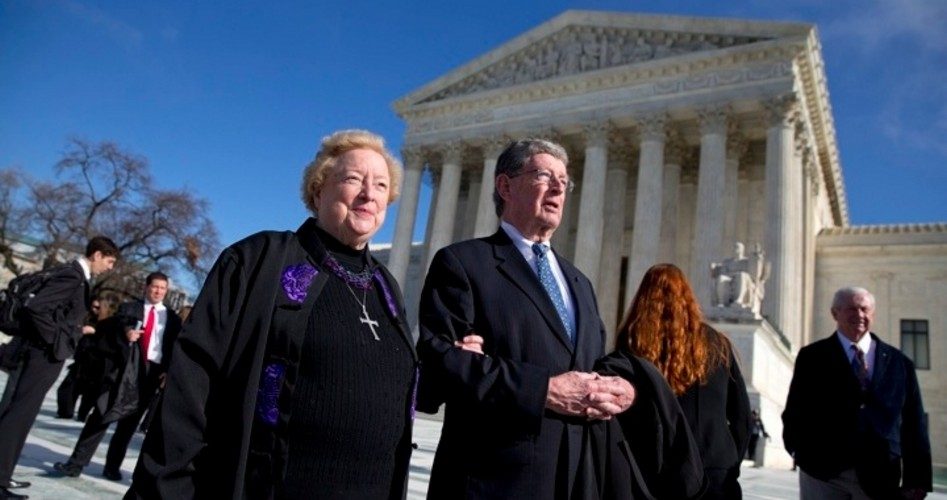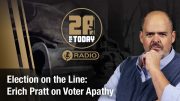
On a court that appeared evenly divided on the constitutionality of a Massachusetts law banning banning abortion protesters from entering a 35-foot buffer zone around entrances to an abortion clinic, Chief Justice John Roberts exercised his right to remain silent.
The chief justice’s silence during a January 15 hearing on a First Amendment challenge to the law was duly noted in news reports on the hearing and was even included in a New York Times headline. While it is not unusual for a justice to refrain, as Clarence Thomas usually does, from taking an active part in the oral arguments, the Roberts silence was notable for two reasons: The chief justice usually engages freely in the rigorous verbal sparring that takes place between the judges and litigants in Supreme Court hearings; and Roberts will cast a crucial vote that could decide the case in a likely 5-4 ruling. Noting that Roberts asked no questions at the hearing, Times reporter Adam Liptak added: “His earlier opinions suggest, however, that he is likely to provide the fifth vote to strike down the law.”
Eleanor McCullen, the lead plaintiff in McCullen v. Coakley, claims the buffer zone limits the free speech rights that she and others seek to exercise by speaking to women on their way into the clinic in an effort to dissuade them from having an abortion. McCullen stands outside the buffer zone at the Planned Parenthood clinic in downtown Boston twice each week. She said she has been able to persuade more than 80 women at the site to cancel abortion plans since the 2007 law went into effect, but insists she could convince even more if not limited by the zone. Women coming to the clinic for abortions are typically conflicted and “mixed up,” she said outside the Supreme Court building January 15, “and if I had another two minutes or three minutes, that’s all I need, but when I’m cut off, it’s very, very frustrating.”
The buffer zones, established at clinics in Wocester and Springfield, Massachusetts, in addition to the one in Boston, is necessary to protect the right of access to the clinics and to defend public safety, Massachusetts officials claim, citing what they have described as a history of harassment and intimidation at clinics, along with a shooting spree that killed two and wounded five at two abortion clinics in Brookline in 1994. Though the space zoned off is a public sidewalk, those who enter the space to make contact with a clinic client could be penalized by up to two-and-a-half years in prison, though no one has yet been prosecuted under the seven-year-old-law. Clinic employees and law enforcement officers are exempt from the ban, as are pedestrians passing through the zone on their way to another destination. One abortion foe, interviewed for the PBS News Hour, raised a safety concern of his own, noting that the semicircular yellow line delineating the buffer zone at the Boston clinic extends across the sidewalk all the way to the curb.
“If you look at that yellow line, it actually puts us out on the street,” he said, “so we’re apt to get hit by a car or a bus or whatever.” Massachusetts Attorney General Martha Coakley, named as a defendant in the suit, told reporters that the law properly addressed both “the huge issue to make sure that no one is hurt or disrupted in their activities” and the rights of protesters who want to be heard. “They do have a right to speak,” Coakley said. “We know it is not unlimited.”
But the extent to which the state may limit that right for public safety reason was what came under scrutiny and serious questioning by the justices.
“I guess I’m just a little hung up on why you need so much space,” Justice Elena Kagan told Assistant Attorney General Jennifer Grace Miller, who argued the case for Massachusetts. Miller claimed there is ample opportunity for free speech outside the 35-foot zone.
“No one is guaranteed any specific form of communication,” she added later. “There is no guarantee, as a doctrinal matter, to close, quiet conversations.” That drew a sharp rejoinder from Justice Anthony Kennedy. “Do you want me to write an opinion and say there’s no free-speech right to quietly converse on an issue of public importance?” he asked, adding that the state, when trying to resolve safety and access issues, also has “a duty to protect speech that’s lawful.”
Mark Rienzi, the lawyer for McCullen and other plaintiffs, also took up the distance issue, merging it with his argument that since clinic employees are allowed to remain inside the zone, the effort to keep protesters out is a constitutionally prohibited limit based on the content of their speech. Rienzi invited the justices to imagine what it would be like in the court if one lawyer had to argue his case from 35 feet away while the other was allowed to remain much nearer to the bench.
“I’d hear you,” Justice Stephen Breyer replied.
“You might hear me,” Rienzi said, “but I would suggest you’d receive it quite differently.”
Rienzi also argued that the law is not narrowly drawn and does resolve the issues it addresses by means least restrictive of free speech as previous court rulings have required. Justice Kennedy suggested the access and public safety problems could be addressed by other state laws previously enacted.
“What’s wrong with the physical obstruction statutes as an answer to the problems Massachusetts is facing?” he asked.
Kennedy was one of three justices who dissented from 6-3 court ruling in 2000, upholding a buffer zone against a First Amendment challenge in Hill v. Colorado. Four of the current members — Bush appointees Roberts and Samuel Alito and Obama-appointed Kagan and Sonia Sotomayor — have been added to the court since the Colorado ruling. Speculation on where Roberts will come down in the current case is based in part on his majority opinion in Snyder v. Phelps, defending the right of a church group to picket military funerals. Alito wrote a bitter dissent in that case, but indicated in his comments and questions Wednesday that the Massachusetts law discriminates on the basis of content of speech.
“Although the Chief Justice failed to tip his hand, it’s hard to imagine a scenario in which he would vote to uphold the law,” predicted Amy Howe on the SCOTUS (Supreme Court of the United States) blog, “and nothing that Justice Samuel Alito said today would have provided any hope to the state.” The court’s ruling, expected at the end of the term in June, might declare any buffer zones unconstitutional or might hold that a smaller zone would sufficiently protect free speech rights to be constitutionally permissible. In an op-ed article in USA Today, Jay Sekulow, chief counsel for the American Center for Law and Justice, called for doing away with the zones altogether.
“Now, in McCullen v. Coakley,” he wrote, “the Supreme Court has an opportunity to scale back the abortion distortion, correct the Hill precedent and reaffirm the primacy of free speech in constitutional jurisprudence.”
Photo of Eleanor McCullen with her attorney outside U.S. Supreme Court: AP Images



